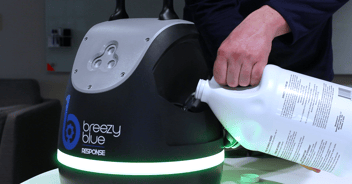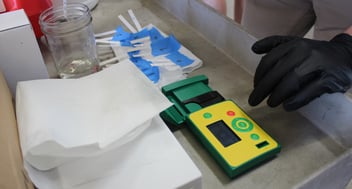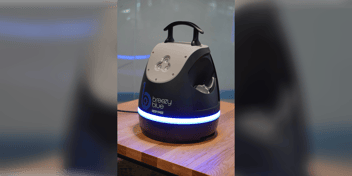Testing Aerosolized Hydrogen Peroxide Disinfection Efficacy in Real World Conditions
Part 1 of this series explains the real-world conditions that affect disinfectant efficacy, and Part 2 explains different methods to test disinfection efficacy in real-world settings. This blog describes an example of applying these tests to measure and validate disinfection efficacy.
At Build With Robots (BWR), we have used all five test methods described in Part 2 within different situations to better understand and validate the use cases for our aerosolized hydrogen peroxide (aHP) disinfection solutions. After years of using the various test methods, we have settled upon a combination of Microbial Culture Testing combined with Electrochemical Sensors for our disinfection efficacy testing and validation. We have found that this combination offers a way to correlate pathogen log reduction efficacy to chemical fog dosage, all of this tested in real-world conditions with real-world variables. Here is how we do our testing.
Overview on BWR's Automated Aerosolized Hydrogen Peroxide Solutions
Our disinfection solutions combine Aerosolized Hydrogen Peroxide (aHP) technology with smart device automation. Our data shows that aHP offers the best combination of efficacy, safety and sustainability. When aerosolized, Hydrogen Peroxide rapidly evaporates by breaking down into hydroxyl ions that recombine into water vapor and oxygen gas. The hydroxyl ions attack essential cell components in an oxidation process. When evaporation is complete, the fully recombined water and oxygen are completely benign, safe, and sustainable. And our smart device automation takes out the variability and unpredictability of disinfecting by hand. Breezy Blue™ is a highly efficient dry fogger that is safe for use on a variety of surfaces, including floors, walls, and electronics. Breezy Blue is a smart device that can be programmed for specific fogging dosages, with all disinfection history stored electronically.
Aerosolized Hydrogen Peroxide Disinfection Test Setup
At BWR, we thoroughly test our disinfection solutions for pathogen reduction efficacy and application safety using Microbial Culture Testing combined with Electrochemical Sensors. Within our Microbial Culture Testing, tiles are coated with non-pathogenic Escherichia coli (E. coli K-12). Figure 1 shows an example of our test tiles. Non-fogged control tiles and tiles exposed to the fogged disinfectant are swabbed, plated, and incubated for 48 hours. When complete, the CFU counts for non-fogged and fogged samples are compared to accurately compute pathogen log kill. Figure 2 shows an example of our incubated plates. When performing microbial testing, we instrument the test room with electrochemical sensors to detect Hydrogen Peroxide gas and other environmental sensors to detect particulate matter (PM2.5), carbon dioxide, humidity, and temperature. Sensors and E. coli tiles are placed throughout a test room to detect disinfectant coverage of larger spaces.
Figure 1. Swabbing tiles coated with E. coli K-12
Figure 2. Cultured plates from Breezy BioCare RTU testing within a 384 cubic foot room
Aerosolized Hydrogen Peroxide Disinfection Test Results
By testing our products for efficacy in a real-world application and experimenting with different variables, BWR can provide recommended fog times for rooms of various sizes. Below are general guidelines for fogging times. All of our aHP fogging guidelines are based upon a 10-minute dwell time post fogging, after which the room can be exhausted using airflow. The values below are based on situations where the room is a regular box shape and there is no airflow in the room for 10 minutes post fogging.
Air flow, room shape, density of surfaces in room, and other environmental variables may affect required fogging time. For these situations, BWR can fine tune fogging times using its soon-to-be-released Breezy Sense™ smart sensor that generates a real-time measurement of disinfectant dosage. Breezy Sense also records an electronic log of a facility’s health through monitoring such things as occupancy, air quality, environmental conditions, and of course, the disinfection history.
We have tested other environmental conditions to determine effects on disinfectant fogging. Our results for aHP disinfection show that elevated temperature increases pathogen reduction, elevated humidity increases pathogen reduction, and airflow that does not dilute air in the room has little effect.
One other application detail that is often needed is reentry time after disinfection. After the 10-minute dwell time post fogging, how long does it take to exhaust a room using airflow and how long does it take for the chemicals to evaporate or settle? Reentry times are heavily dependent on variables such as ventilation, size and shape of a space, and chemistry used (Breezy BioCare RTU or Breezy BioPure RTU). To determine when it is safe to reenter, we use the OSHA levels for Hydrogen Peroxide and the EPA levels for PM2.5 particulate matter. Every space is unique, and airflow (HVAC or otherwise) has the largest impact on reentry times. Again, Breezy Sense offers a good method to directly measure and communicate reentry conditions.
As a side note, in our attempt to qualify other chemistries for use with Breezy Blue, we have tested many other disinfectants using these test protocols. Unfortunately, we have found other disinfectants to be lacking in one or more of the following areas: low efficacy, too wetting, highly corrosive, and/or highly toxic.
Summary
At BWR, we use science, technology, and data to develop our products and solutions, and to educate our users and partners. Because the COVID-19 pandemic created some confusion and misinformation related to effective disinfection, it is most important that we be very thorough in validating our products and their use cases. We want to ensure that our users can keep their facilities healthy and safe, and can promote their efforts to their occupants and visitors.
Part 1: Breezy BioCare RTU: Why Real-World Efficacy Testing is Needed
Part 2: Five Methods of Testing Disinfection Efficacy in the Real World
Part 3: Testing Aerosolized Hydrogen Peroxide Disinfection Efficacy in Real World Conditions




